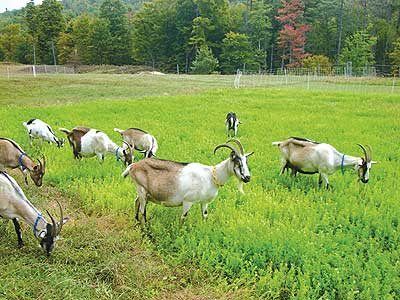 |
| Goats grazing lespedeza at Little Falls Farm. Photo by Katy Green |
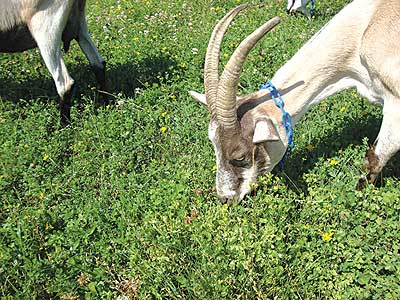 |
| Goats grazing big trefoil at Little Falls Farm. Photo by Katy Green |
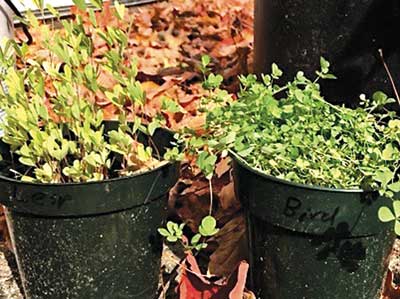 |
| Pots of lespedeza (left) and trefoil planted by Jean Noon. Photo by Jean Noon |
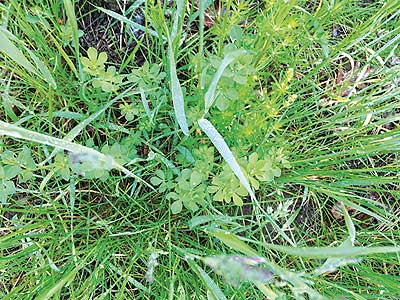 |
| Trefoil regrowth in 2017. Photo by Diane Schivera |
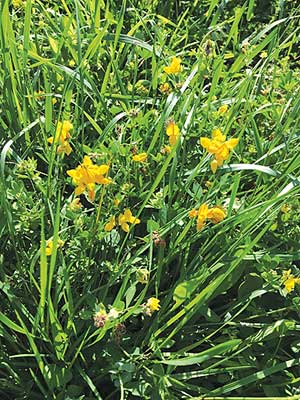 |
| Trefoil regrowth in 2017. Photo by Jean Noon |
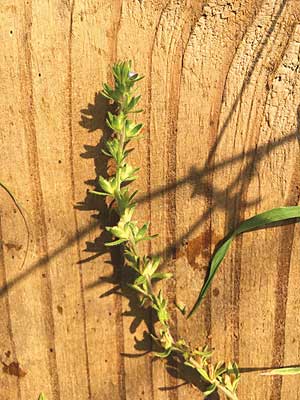 |
| Lespedeza regrowth in 2017. Photo by Jean Noon |
By Diane Schivera, M.A.T.
I was a project director for USDA Sustainable Agriculture Research and Education (SARE) Partnership project ONE14-203, High-tannin pasture plantings, evaluating the potential for growing sericea lespedeza and big trefoil as perennial crops in Maine. Both are valuable pasture crops for sheep and goats because their leaves have relatively high levels of tannins. Numerous studies have shown that plants high in condensed tannins help reduce populations of Haemonchus contortus (barber-pole worm), a parasite that can be a serious threat to small ruminant animals. These plants have been grown and used in the Southern United States for many years, but very little in the Northeast.
The SARE project evaluated whether sericea lespedeza (Lespedeza cuneata) and big trefoil (Lotus uliginosus, also known as L. pedunculatus in the Northeast) could survive Maine winters and be grown as perennials in pasture, or whether they would die and could be used only as annual crops.
During the first two years (2014-2015), cooperating Maine farmers John and Mary Belding of Little Falls Farm in Harrison and Patti Hamilton of Hamilton Farm in Whitefield managed half-acre strips each of trefoil and lespedeza on their farms. The fields were tilled and seed broadcast at rates of 4 pounds per acre of trefoil and 25 pounds per acre of lespedeza. The strips were grazed or mowed for one to three days at a time, with animals returning to graze when crops recovered. Both crops were also trailed at MOFGA’s Common Ground Education Center in Unity in a randomized complete block design of 10- x 10-foot plots of each species alone and combined with perennial rye, using the same relative seeding rates as above.
Large trefoil survived well at Little Falls Farm in both years, while plantings at MOFGA and at Hamilton Farm were sparse due to weed pressure. The Beldings had tilled their plot more than a few times before planting, giving weed seed a chance to germinate for better control. The Beldings tilled their plots under in spring 2016 because weed pressure had built up by then and because they needed the field for other production. Also in 2016, the plantings at Hamilton Farm were tilled in. The 2015 planting at MOFGA was tilled under in the spring of 2016, and we attempted another planting in 2016, but because of drought, no lespedeza and only a few clumps of trefoil germinated. The 2016 plantings at MOFGA were exhibited, with signage, at the Common Ground Country Fair.
Lespedeza seedings from 2014, 2015 and 2016 did not survive the winter in any of the mid-Maine plantings. We had intended to evaluate biomass production at MOFGA by harvesting and drying plants from 0.25-meter-square plots of each species alone and each in combination with perennial rye, but insufficient production prohibited this.
Jean Noon of Noon Family Sheep Farm in Springvale, Maine, planted 10- x 10-foot plots with our remaining seed (approximately 1 ounce each) on August 1, 2016, and she sowed some seeds in pots for an informal look at seed viability. Her planting was fairly well established in 2016, and both lespedeza and big trefoil survived the milder Southern Maine climate in 2016-2017. The stands were not thick due to pressure from competing plants, but they did survive and flower, so both plants appear to offer some potential for parasite control for sheep and goats in Southern Maine.
The trefoil planting at MOFGA survived the winter, and some of the seed from 2016 appeared to germinate. It was encouraging to see the dormant trefoil seed germinate in 2017 despite serious competition and drought in 2016. Unfortunately the planted area had to be tilled in for another use in 2017.
Seed of both big trefoil and lespedeza is very small, so a very clean seedbed is required for a successful stand. A firm seedbed also helps when sowing small-seeded crops, so the soil would likely have to be rolled after tillage.
Big trefoil has potential for planting in the Northeast since it will survive wet, poorly drained, low pH soils. It actually has higher tannin levels when grown in lower fertility soils, according to C.J. Kaiser, C.J. and M.E. Heath (Big trefoil: A new legume for pastures on fragipan soils; in J. Janick and J.E. Simon (eds.), “Advances in new crops,” Timber Press, Portland, Oregon, 1990; https://hort.purdue.edu/newcrop/proceedings1990/V1-191.html).
I recommend that farmers in mid-Maine try to establish plantings of Lotus uliginosus, given the seed survival and germination rate. Sericea lespedeza survived in Southern Maine but must be used as an annual in mid-Maine and farther north. Organic farmers seeking the benefits of lespedeza for their livestock will have to raise their own; conventional farmers can buy it as pellets and hay. Some people are concerned that lespedeza can become invasive, as it has in areas of the Midwest and South.
About the author: Diane Schivera is MOFGA’s organic livestock specialist. You can reach her at [email protected].
